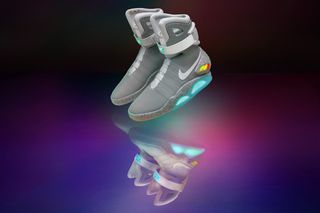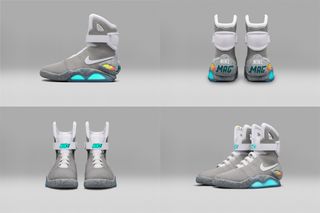Great Scott! How to Get the 'Back to the Future' Self-Lacing Shoes

"Power laces — all right!" In "Back to the Future Part II," teenage time traveler Marty McFly (Michael J. Fox) was understandably impressed by a pair of sneakers that conformed to his feet and laced themselves automatically.
It only took 27 years, but Nike has produced those science-fiction kicks and is putting them up for grabs. But there's a catch: Only 89 pairs are available. ['Star Wars' Tech: 8 Sci-Fi Inventions and Their Real-Life Counterparts]
The limited-edition release of the 2016 Nike Mag offers the self-lacing sneakers through an online lottery in collaboration with the Michael J. Fox Foundation for Parkinson's Research. Lottery entries can be purchased with a $10 donation to the foundation; 100 percent of all the proceeds will go toward research for a Parkinson's cure, according to a statement released by Nike.
The shoes' big scene in the film lasted less than 30 seconds, but it was long enough for them to make a big impact on moviegoers — and to inspire Nike executives and designers. Nike Mags closely resemble the sneakers that so impressed Marty McFly nearly three decades ago. A system called "adaptive fit" uses sensors to tighten or loosen the shoe to conform to the wearer's foot.
This isn't the first time that Nike has tantalized science-fiction fans with promises of self-lacing sneakers. On March 16, the company announced the forthcoming debut of the Nike HyperAdapt 1.0, declaring in a statement that the shoe would be "the first performance vehicle for Nike's latest platform breakthrough, adaptive lacing."

Nike representatives described a sensor in the sneaker's heel that would detect the wearer's foot inside the shoe, triggering the system to adjust the fit.
However, the HyperAdapt's promised release — the 2016 holiday season — would only accommodate Nike+ members, and Nike did not specify how much the shoes would cost or when they would be more widely available.
Sign up for the Live Science daily newsletter now
Get the world’s most fascinating discoveries delivered straight to your inbox.
The lottery for a chance to snap up the new Nike Mag sneaker, on the other hand, is already underway.
If the shoe fits
From Oct. 4 to Oct. 11, residents of the U.S. and Canada can purchase entries to win a pair of Mags on the Nike website or the Nike app. There is no limit to the number of tickets that hopeful entrants can buy, and winners will be notified Oct. 17.
Three additional pairs of Nike Mags will be auctioned off during fundraising events in three cities: Hong Kong on Oct. 11, London on Oct. 14 and 17, and New York on Nov. 12.
Considering Fox was the first to wear the futuristic shoe when it was just a gleam in a special-effects prop master's eye, it seems only right that he would be the first to test out the sneaker in the real world — and Nike delivered the first pair of Nike Mags to Fox in 2015.
"Though it initially shared only a few seconds of screen time with Michael, the idea behind the Nike Mag unlocked something much bigger at Nike," Mark Parker, Nike's chairman, president and CEO, said in a statement. "It sent us down an uncharted path of innovation, but it also opened our eyes to our ability to fight some of the world's biggest challenges. We feel privileged for the opportunity to raise even more awareness for the fight against Parkinson's," Parker said.
Original article on Live Science.

Mindy Weisberger is an editor at Scholastic and a former Live Science channel editor and senior writer. She has reported on general science, covering climate change, paleontology, biology, and space. Mindy studied film at Columbia University; prior to Live Science she produced, wrote and directed media for the American Museum of Natural History in New York City. Her videos about dinosaurs, astrophysics, biodiversity and evolution appear in museums and science centers worldwide, earning awards such as the CINE Golden Eagle and the Communicator Award of Excellence. Her writing has also appeared in Scientific American, The Washington Post and How It Works Magazine.

